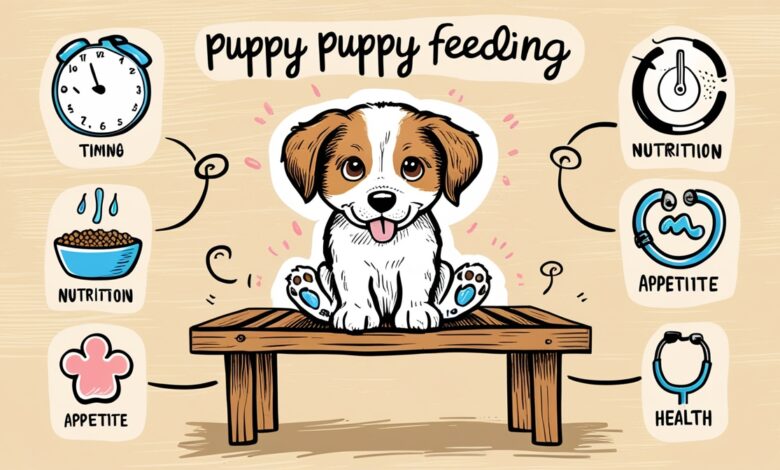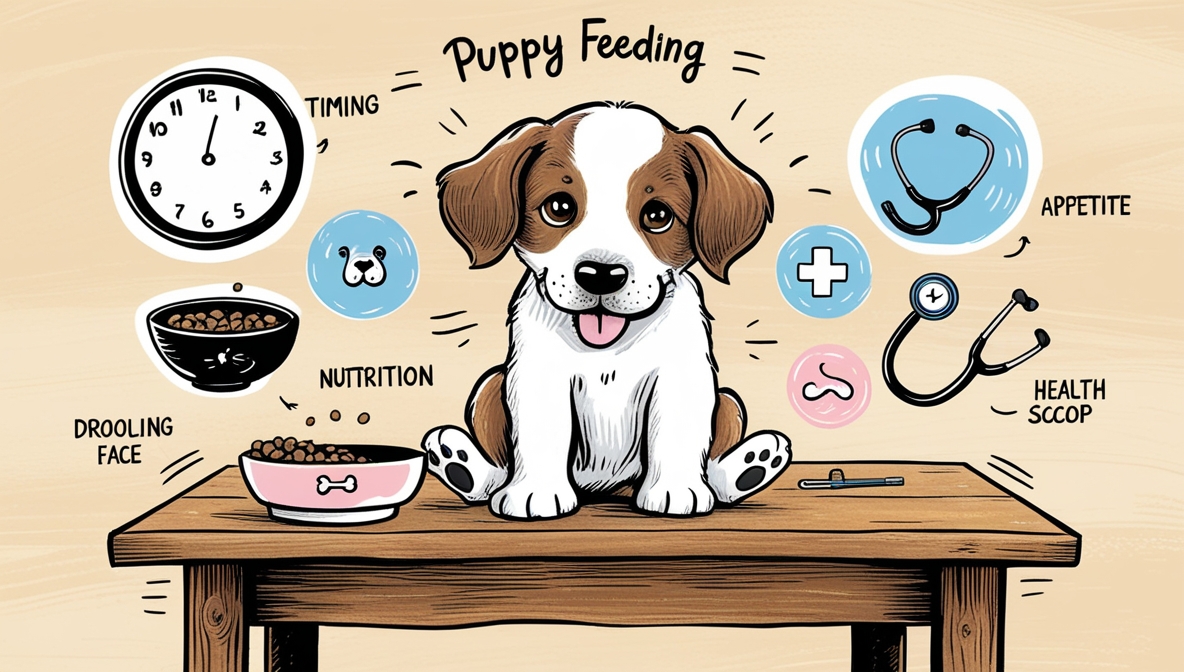How Much to Feed an Australian Shepherd Puppy? Feeding Guide

Puppy nutrition is crucial for the healthy development of your Australian Shepherd. Knowing how much to feed your puppy can be overwhelming, but establishing the right diet is necessary to prevent obesity and ensure they grow into a strong, active adult. Your puppy’s feeding amount varies based on age, weight, and activity level. In this guide, you will discover recommended feeding amounts, nutritional needs, and tips to avoid common feeding mistakes. By following this guide, you can ensure that your furry friend has a balanced diet that promotes optimal health and energy levels.

Key Takeaways:
- Age and Weight Considerations: Factors such as the puppy’s age and weight significantly influence the amount of food they need daily.
- Quality of Food: Providing high-quality, nutrient-dense food is imperative for healthy growth and development in Australian Shepherd puppies.
- Feeding Schedule: Establishing a consistent feeding schedule helps regulate digestion and supports a healthy routine for your puppy.
Types of Food for Australian Shepherd Puppies
The right nutrition is crucial for your Australian Shepherd puppy’s growth and development. Choosing the appropriate type of food is vital to ensure they receive all necessary nutrients. Here’s a breakdown of the main types of food available for your puppy:
| Type of Food | Description |
|---|---|
| Dry Kibble | Convenient and helps maintain dental health. |
| Wet Food | Offers moisture and a palatable taste. |
| Homemade Diet | Allows you to control ingredients and adjust portions. |
| Raw Diet | Focuses on uncooked meats and fresh produce. |
| Specialty Dog Food | Formulated for specific needs (e.g., allergies, sensitivities). |
Dry Kibble
If you choose to feed your Australian Shepherd puppy dry kibble, it is important to select a high-quality brand specifically formulated for puppies. Kibble provides vital nutrients and promotes healthy teeth. Ensure the kibble is rich in animal protein, healthy fats, and vital vitamins and minerals.
Wet Food
To provide your puppy with a more enticing alternative, wet food can be an excellent option. It is often more palatable for puppies and contains higher moisture content, which helps keep them hydrated. However, it is crucial to read the labels to ensure all ingredients are high quality.
The combination of wet food with dry kibble can also offer a variety of textures and flavors that your Australian Shepherd puppy may enjoy. This can be particularly beneficial if your puppy is a picky eater or if you notice a decline in their interest in dry kibble over time. When identifying wet food, check for real meat as the first ingredient and avoid products with excessive fillers and preservatives.
Homemade Diet
The option of a homemade diet allows you to have full control over what your puppy consumes. This can ensure they receive the best quality ingredients tailored to their specific needs. However, it is important to consult with your veterinarian to create a balanced diet that meets their nutritional requirements.
A homemade diet can incorporate a variety of ingredients including lean proteins, whole grains, and vegetables, ensuring they receive a comprehensive mix of nutrients. Just remember to avoid poisonous foods for dogs, such as chocolate, onions, and grapes. Your vet can provide recommendations to ensure your puppy’s homemade meals are safe and nutritious. Thou, keeping your puppy well-nourished should always be a top priority.

Tips for Feeding Australian Shepherd Puppies
Some necessary tips for **feeding Australian Shepherd puppies** can help ensure their well-being and growth during this critical phase. Follow these guidelines:
- Choose high-quality, age-appropriate dog food.
- Be consistent with **feeding times** to build a routine.
- Transition gradually to new foods to avoid stomach upset.
- Keep bowls clean and fresh with water available at all times.
- Consult your veterinarian for personalized advice.
The right approach will keep your puppy healthy and thriving.
Establishing a Feeding Schedule
Clearly establishing a **feeding schedule** is crucial for your Australian Shepherd puppy’s health. Consistency helps create a sense of security, aiding digestion and reducing anxiety. Aim to feed your puppy at the same times each day, which should be spaced out to accommodate their energy needs and digestive capabilities.
Monitoring Portion Sizes
Little adjustments in **portion sizes** can significantly impact your puppy’s growth and health. It’s vital to follow the feeding guidelines on your puppy’s food packaging, accounting for their age, weight, and activity level. Overfeeding can lead to obesity, while underfeeding can stunt growth, so striking the right balance is necessary.
Feeding your Australian Shepherd puppy appropriate **portion sizes** involves not only adhering to the manufacturer’s recommendations but also observing your puppy’s physical condition. Look for signs of healthy weight, such as a defined waist and ribs that are easily felt but not prominently visible. Regular check-ins with your veterinarian will help ensure your puppy is on the right track.
Ensuring Nutritional Balance
If you want to provide the best care for your puppy, ensuring **nutritional balance** is key. A well-balanced diet tailored to their specific needs fosters optimal growth and development. Make sure their food contains a proper mix of proteins, carbohydrates, fats, vitamins, and minerals suitable for their age and activity level.
Ensuring your puppy receives a balanced diet not only promotes **physical health** but also supports cognitive development, which is particularly important for intelligent breeds like Australian Shepherds. Keep an eye out for any signs of allergies or sensitivities, and consult your veterinarian if you suspect any issues with their diet. Proper nutrition lays the foundation for a long and healthy life for your puppy.
Step-by-Step Feeding Guide
Your puppy’s diet is crucial for their growth and overall health. This step-by-step feeding guide will help you understand how much to feed your Australian Shepherd puppy at different stages of their development. Follow these guidelines to ensure your pup thrives during this critical time.
Feeding Guide
| Age | Daily Food Amount |
|---|---|
| 8-12 weeks | 1-2 cups, divided into 3-4 meals |
| 3-6 months | 2-3 cups, divided into 3 meals |
| 6-12 months | 3-4 cups, divided into 2 meals |
| 12 months and older | 2-3 cups, depending on activity level |
Initial Preparation
Initial preparation is imperative for a smooth feeding routine. First, select a high-quality puppy food that meets AAFCO standards specifically for large breeds. Ensure you have appropriate feeding bowls that are the right size for your puppy. Finally, designate a feeding area that is quiet and free from distractions, as this will help your puppy focus on their meals.
Feeding Frequency
Clearly, knowing how often to feed your pup is vital for their development. Puppies require multiple meals throughout the day to support their energy needs and growth. Typically, Australian Shepherd puppies should eat three to four times a day until they are about six months old. After that, you can gradually transition to two meals a day.
Feeding multiple meals allows your Australian Shepherd puppy to digest food better and absorb nutrients more efficiently. It also helps them maintain steady energy levels throughout the day. Do not forget, consistency in their feeding schedule is crucial as it prepares them for a routine and promotes healthy eating habits as they grow.
Transitioning Between Foods
Clearly, transitioning between food types should be done gradually to avoid gastrointestinal upset. Start by mixing a small amount of the new food with the old food, increasing the new food’s proportion over a period of about a week. This method helps your puppy adapt to the new food without stressing their digestive system.
Frequency and gradual transitions are key when changing your puppy’s diet. It’s imperative to monitor your puppy for any signs of digestive discomfort, such as diarrhea or vomiting. If these symptoms occur, slow down the transition process. Following this approach will help your Australian Shepherd puppy smoothly adjust to new dietary changes while ensuring their health and well-being.

Factors Influencing Puppy Feeding
Many factors influence how much you should feed your Australian Shepherd puppy. These can significantly impact your puppy’s nutrition and overall well-being. Among these factors are:
- Age and Development Stage
- Activity Level
- Health Considerations
After considering these elements, you can create a more tailored feeding routine for your puppy.
Age and Development Stage
To ensure optimal growth and health, you need to adjust your puppy’s food intake based on their age and development stage. Puppies have varying nutritional needs as they transition from weaning to adulthood. During the initial months, focus on providing a balanced diet that supports their rapid growth.
Activity Level
Level of activity significantly dictates your puppy’s calorie intake. An active Australian Shepherd puppy requires more food compared to a less active one to maintain energy levels. Puppies that engage in regular play, walks, or agility training may need to be fed a nutrient-rich diet.
Feeding strategies must adapt to the activity level of your Australian Shepherd. Regular high-energy play sessions or training activities demand increased calories and protein, ensuring your puppy remains energized and healthy. Evaluate their daily activities to determine if any adjustments to their feeding portions are necessary.
Health Considerations
One crucial aspect to consider when feeding your Australian Shepherd puppy is their health conditions. Certain health issues may require specialized diets or restricted calorie intake to maintain a healthy weight.
Understanding your puppy’s health conditions can help in selecting the right food. For example, if your puppy has allergies, you must avoid specific ingredients that could irritate their condition. Additionally, monitoring weight is vital, as an obese puppy could face severe health issues like joint pain or heart problems. Always consult your veterinarian for personalized feeding advice that addresses both general and specific health concerns.
Pros and Cons of Different Feeding Methods
Not all feeding methods are created equal. Each option has its unique advantages and disadvantages, which can significantly affect your Australian Shepherd puppy’s health and development. Below, you will find a comprehensive breakdown of the pros and cons of various feeding methods.
| Feeding Method | Pros and Cons |
|---|---|
| Dry Kibble | Easy to store and portion; often cheaper; promotes dental health. |
| Wet Food | More palatable; higher moisture content; can be more appealing to picky eaters. |
| Raw Diet | May improve coat health; can lead to increased energy levels; less processed. |
| Homemade Diet | Allows complete control over ingredients; can be tailored to your puppy’s needs; fresher food. |
| Commercially Prepared Frozen Meals | Convenient; often uses high-quality ingredients; nutritionally balanced. |
| Free Feeding | Convenient for busy schedules; may allow for self-regulation. |
| Timed Feeding | Helps establish a routine; allows for better weight control. |
| Mixing Foods | Combines the benefits of different types; increases variety; may support complete nutrition. |
Pros of Dry Kibble
Feeding your Australian Shepherd puppy dry kibble is a convenient option. It is easy to store, affordable, and aids in promoting dental health through chewing. Additionally, dry kibble often comes with balanced nutrition tailored for puppy growth, making it a popular choice among pet owners.
Cons of Wet Food
One potential downside to wet food is its higher cost compared to dry kibble. Additionally, wet food can spoil quickly if not refrigerated after opening, which may lead to increased waste. Lastly, some wet foods may contain fillers or low-quality ingredients, so it’s crucial to read labels carefully.
Another important consideration is that feeding your puppy wet food can lead to weight gain if not monitored closely. Puppies often find it more tempting and may overeat, contributing to an unhealthy weight. It’s important to measure servings accurately to prevent any adverse effects.
Advantages of Homemade Diet
Methods for feeding a homemade diet to your Australian Shepherd puppy offer numerous benefits. This approach allows you to have full control over the ingredients, ensuring your puppy receives fresh, nutritious meals devoid of harmful additives or fillers. It can also be customized to address specific dietary needs.
Advantages of a homemade diet include the ability to tailor meals to your puppy’s preferences and nutritional requirements. As you prepare meals, you can incorporate a variety of high-quality proteins, vegetables, and grains, ensuring your diet is well-rounded and meets all important dietary guidelines for healthy growth. However, it is crucial to consult a veterinarian to create balanced meals and avoid nutritional deficiencies.
Summing up
With this in mind, understanding how much to feed your Australian Shepherd puppy is crucial for their growth and development. You should always refer to the feeding guidelines on your puppy’s food packaging, considering their age, weight, and activity level. Regularly monitor their body condition and adjust portions as needed. Don’t hesitate to consult your veterinarian for personalized advice to ensure your puppy gets the best start in life. By doing so, you will help your Australian Shepherd thrive and grow into a healthy adult dog.
For further information, consider visiting:
- American Kennel Club: Puppy Feeding Guide – This guide from the AKC provides comprehensive advice on feeding puppies, including portion sizes and frequency.
- PetMD: Puppy Nutrition – PetMD offers insights into the nutritional needs of puppies and how to determine the right amount of food.
- The Spruce Pets: How Much to Feed a Puppy – This article outlines general guidelines for puppy feeding, including factors that affect food quantity.
- Hill’s Pet Nutrition: Feeding Puppies – Hill’s provides detailed information on puppy nutrition and feeding schedules tailored to different breed sizes.
FAQ
Q: How much food should I feed my Australian Shepherd puppy based on its age?
A: The amount of food you should feed your Australian Shepherd puppy varies with its age. Generally, puppies aged 8 to 12 weeks should be fed about 1 to 1.5 cups of high-quality puppy food per day, divided into three to four meals. As they grow, gradually increase the amount: from 3 to 6 months, feed approximately 1.5 to 2.5 cups per day, divided into three meals; from 6 months to 1 year, feed between 2 to 3 cups per day. Always consult with your veterinarian to tailor the feeding schedule to your puppy’s specific growth needs and activity level.
Q: What type of food is best for an Australian Shepherd puppy?
A: When choosing food for your Australian Shepherd puppy, look for high-quality commercial puppy food that lists meat as the first ingredient and contains all imperative nutrients needed for growth. A balanced diet should include proteins, healthy fats, and carbohydrates, along with vitamins and minerals. It is advisable to select a puppy formula specifically designed for medium to large breeds to ensure proper growth. Always opt for brands that are well-regarded and have undergone feeding trials, or consult your veterinarian for recommendations on suitable brands.
Q: How often should I feed my Australian Shepherd puppy?
A: Australian Shepherd puppies should be fed multiple times a day to support their rapid growth and high energy levels. Puppies aged 8 weeks to 6 months should be fed three to four meals a day. After six months of age, you can transition to feeding them twice a day. It’s imperative to maintain a consistent feeding schedule and provide food at the same times each day. Make sure fresh water is always available. As your puppy matures and its energy needs change, you can adjust meal frequency accordingly.





